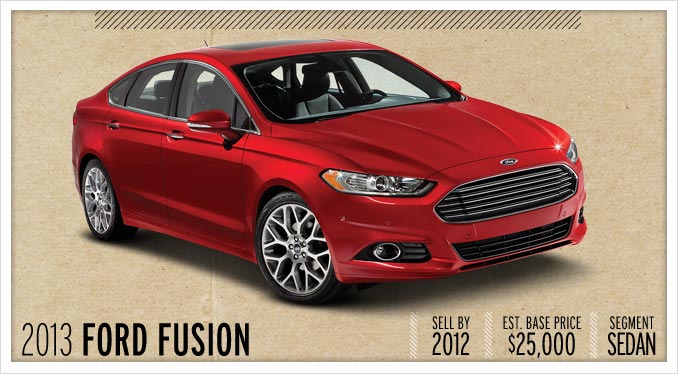|
|
Last year’s stunning Evos concept previewed the 2013 Fusion’s styling, and the production sedan looks like, well, a bigger, better-looking Focus, or possibly a smaller, better-looking Taurus. Surprised? Neither are we. But lack of astonishment or no, there’s no denying that the new Fusion is fetching. It’s a mid-size sedan with the elegance of a luxury car, an impression hammered home by that Aston Martinian grille. Ford seems to think that it still owns the brand of Bond, even though it offloaded it back in 2007.
Under the hood, however, Ford is tendering no illusions—the range of economical engine options encompasses conventional, hybrid, and plug-in-hybrid alternatives. Those who opt to go strictly fossil fuel have three choices: a 170-hp, 2.5-liter four-cylinder mated to a six-speed automatic; a 179-hp, 1.6-liter EcoBoost turbo four mated to either a six-speed auto or a six-speed manual; and a 237-hp, 2.0-liter EcoBoost four hooked to a six-speed automatic. (All power figures are estimates, but they’re not likely to change much.) All-wheel drive is again available but only with the 2.0-liter. An engine stop-start system will be offered exclusively on 1.6-liter models, where it is said (by Ford) to reduce fuel consumption and emissions by 3.5 percent.
Fusion hybrid buyers get a new 2.0-liter, Atkinson-cycle four-cylinder to replace the outgoing 2.5-liter. A permanent-magnet AC synchronous motor holds up the electrical end of the momentum bargain, helping to boost total system output to 185 horsepower and 130 pound-feet of torque. An electronically controlled continuously variable transmission sends the power to the wheels. Lighter, more powerful lithium-ion batteries replace the previous Fusion hybrid’s nickel-metal hydride batteries and increase the electric-only top speed from 47 to 62 mph. Efficiency numbers aren’t final yet, but Ford is calling out Toyota and Hyundai, claiming the Fusion hybrid stands to outperform the 2012 Toyota Camry hybrid by 4 mpg in the city and 5 mpg on the highway and the 2011 Hyundai Sonata hybrid by 12 and 4 mpg, respectively. For those not inclined to do the math, that translates to early estimates of 47 mpg city and 44 highway for Ford’s gas-electric sedan.
Truly dedicated hypermilers will want to wait a few months after the above Fusion models launch, though, when the Fusion Energi plug-in hybrid makes its debut. Similar to the Fusion hybrid but with the added advantage of plug-in battery recharging, the Energi is anticipated to return more than 100 MPGe. (MPGe stands for “miles per gallon equivalent,” a metric that allows efficiency comparisons of electrified and conventional vehicles.)
In addition to a long list of nanny tech aimed at those overwhelmed by the prospect of paying attention behind the wheel—adaptive cruise control, a lane-keeping system, blind-spot warning, active park assist—you’ll also find the polarizing if updated MyFord Touch system on the options list. Ford isn’t saying much else about the Fusion’s various levels of equipment, other than they will be meted out via S, SE, and Titanium trims. We expect that, like the Focus, the Fusion will be priced at the high end of its class.
The company gives those who like to drive a pat on the head, too, saying that the electric power steering, strut front suspension, and multilink rear suspension team up to “please a well-seasoned enthusiast.” As this car is based on the European Mondeo, we have no doubt. But what about those of us who could use a bit more salt?
|
|
View Photos
View Photos


Leave a Reply